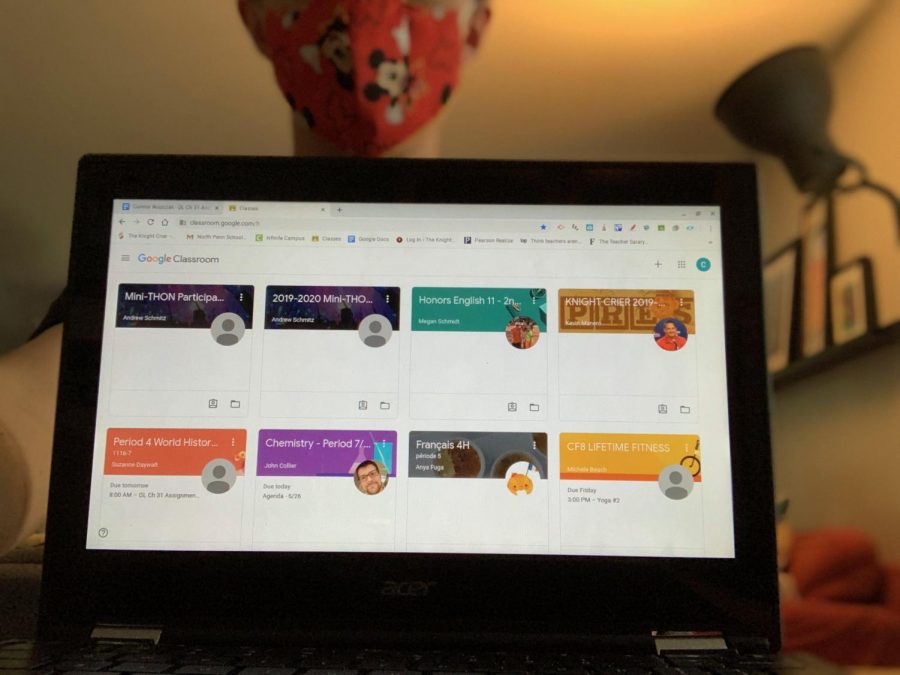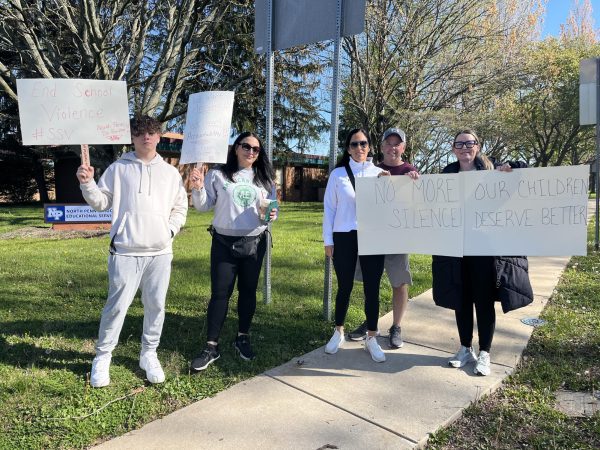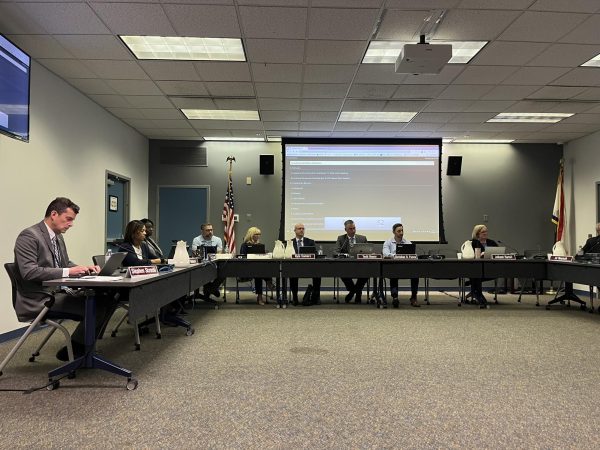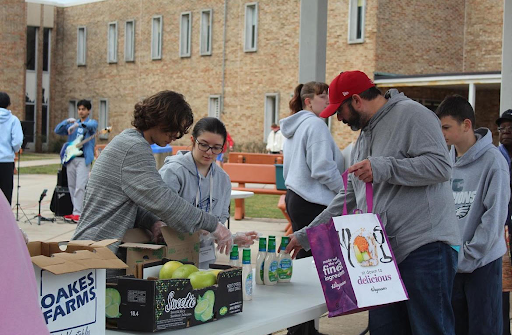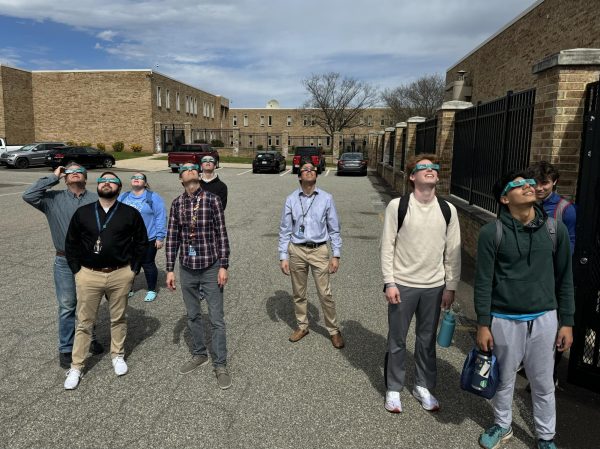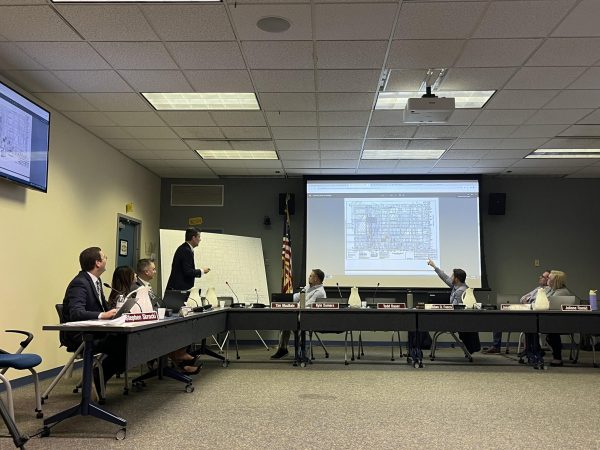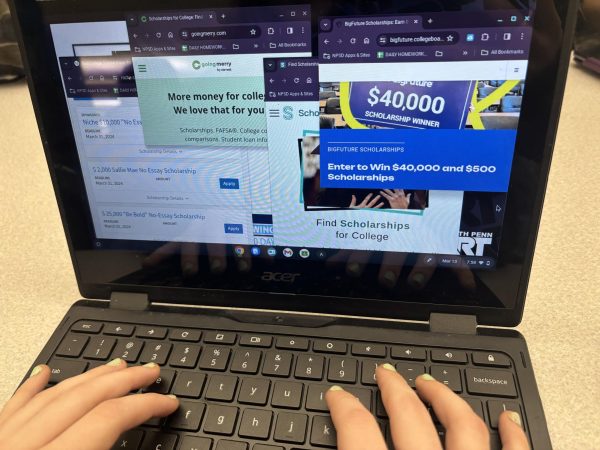We’ve gone the distance
It’s 6 AM. Once again, that dreaded visitor starts knocking on your door.
“Brring! Brrring! Brrrrrring!”
Most North Penn High School students loathed the sound of their alarm more than almost anything else in life.
But these days, a student may be woken up by an intrusive sibling or the smell of coffee just as much as by an iPhone alarm.
Ever since distance learning began on March 30th, there have been no early morning spring sport workouts, no stragglers sprinting through the parking lot at 7:20, and no booming Mr. Manero to bring the building alive. North Penn High School is in the middle of one long, silent Knight.
For two months now, all 3,000 students and 200 teachers have still been learning. Still balancing chemical equations, reading about Holden Caulfield and Jay Gatsby, and conjugating verbs… but from home.
Making the switch to distance learning left many students, parents, and teachers with more questions than answers.
I think a major worry I heard from teachers and students as we began distance learning was about time. There was some concern that there would be mandated times that students or teachers needed to be online, similar to when we are all in school.
— Mr. Nicholson, NPHS Principal
“I think a major worry I heard from teachers and students as we began distance learning was about time. There was some concern that there would be mandated times that students or teachers needed to be online, similar to when we are all in school. With teachers, in many cases, having their own children at home and many students having to work longer hours at their jobs, many were concerned that we would mandate everyone to be online from 7:21-2:12, just like we were in school. I think that allowing the flexibility in our plan that we did help alleviate many of those concerns,” said North Penn High School Principal Pete Nicholson.
Some students took the first two weeks of assignment-free quarantine as an extended spring break, but quickly adapted to the realities of this new normal.
“The transition wasn’t insane. I think initially I took it like an early spring break. That being said, I knew it was important to stay on top of things, especially since this last marking period could tip some of my grades since they were borderlining. So going into quarantine, I immediately started to organize myself into how I was going to get my work done for school. I actually found it pretty easy to get into a rhythm and routine, since I was used to putting in long hours at school; sitting down and getting stuff done wasn’t too bad,” expressed junior Aranza Trejo-Mora.
I knew it was important to stay on top of things, especially since this last marking period could tip some of my grades since they were borderlining. So going into quarantine, I immediately started to organize myself into how I was going to get my work done for school.
— Aranza Trejo-Mora, NPHS Junior
Instead of the often monotonous seven hour school day, students now start their day by checking Google Classroom to gather their assignments.
“The transition to distance learning was not hard for me. I like to work on school work at my own pace, so when teachers post the assignment and I get to choose which subject to work on first, it was nice. And for most classes, I don’t have to wait for others in the class and work with them in order to move on to the next topic,” said senior Tori Quinn.
All subject areas have had their struggles, but the languages of B pod have had to deal with especially unique challenges.
“It’s easy to incorporate reading, listening & writing activities into remote learning activities but speaking is definitely the most challenging of the 4 skills. Students in levels 4 and 5 are motivated and want to speak (especially the APs who have a clear goal in mind). Level 3 has been more of a challenge. Teachers in the World Language Dept. have been using Flipgrid, online voice recorders, smartphone apps, student-made videos, voiceover Google Slides, iMovie, and regular, optional Google Meets to speak in the target languages. I want to also note that this year’s AP language exams (French, German, Spanish, Japanese) are only speaking activities which are traditionally the 2 most challenging parts of the test (traditional test is reading, writing, listening, speaking). So all of our practice for the past several weeks have been speaking activities. I am blown away by how far the students have come and the quality of the work when that is all we have been focusing on,” said World Language Department Chair Anita Sapalidis.
Since so much of language comprehension and skill-building comes through speaking in class, some students have gotten creative in order to not lose the skills they built up in the classroom this year.
“A speaking activity doesn’t necessarily have to be with another person. We have had students record themselves reading stories. One student made a video where she narrated making crepes. We have been surprised at how many students have told us about finding music, movies, and even TV series they have found on Netflix, etc. that are in their target language. We are happy that they have been listening to the language,” Sapalidis added.
The fact that students are not required to be online at a certain time has allowed much more flexibility for the wide range of learning styles of NPHS students, from the early birds to those who roll out of bed at noon and everyone in between.
“Whether or not I have work affects the time I get up and do school work. When I don’t have work, I am up at 7:30 and I start on my two class assignments that are always posted at 7 and then I continue with the rest of the work as it gets assigned. When I do have work, I am up at 6:30, then I go to work, and I am generally back home between 1-3 and then get started on my homework,” said Quinn.
“I usually wake up around 11 or 12 and finish it all by 3,” added sophomore Matt Biswas.
According to a number of students, the biggest challenge they’ve had to deal with since distance learning began is a lack of motivation.
Responses ranged from “The fact that there’s very little impact on our grades. There’s no incentive to try,” and “No motivation. AT ALL,” to “I don’t actually learn. I’m just trying to submit the work in time so I don’t lose points,” and “The lack of feedback and transparency from teachers that used to be available 1 on 1.”
Teachers have just as many, if not more, struggles and stress surrounding distance learning, but they are still doing their best to make sure their students are staying safe.
Trying to stay connected with students has been a goal of our department over the past several months. We worry when we don’t hear from a student for even a few days in a row.
— Madame Sapalidis, World Language Department Chair
“Trying to stay connected with students has been a goal of our department over the past several months. We worry when we don’t hear from a student for even a few days in a row. I think everyone is in somewhat of a routine now but those first few weeks were stressful as many of us were forced to begin working with technology ways that we hadn’t experienced before, but it was a good thing! I have been thinking about how remote teaching/learning will change my classroom experience when we are back in the building. I have always wanted to flip my classroom and now that I am actually doing that, I would love to continue to do this – have students do the mundane grammar tasks at home and use class time for speaking and more dynamic activities,” Sapalidis said.
In two weeks, North Penn High School will finish distance learning for the 2019-2020 school year. For many in the NPHS community, it still feels like just yesterday that we were back in those crowded hallways, not knowing how the last three months of the academic year would be historically affected by the COVID-19 pandemic. Strange as it may be, we—students, teachers, administrators, and parents alike—have made this our new normal.
“Over the last seven or so weeks, I think everyone has adjusted to this new normal. I know at first it was a shock to have emails come in at 2:00 AM or work turned in at 4:00 AM but that’s just the way it is now. The flexibility has really allowed everyone, including teachers and administrators, the ability to manage their own family commitments along with the needs of our students,” Nicholson concluded.


